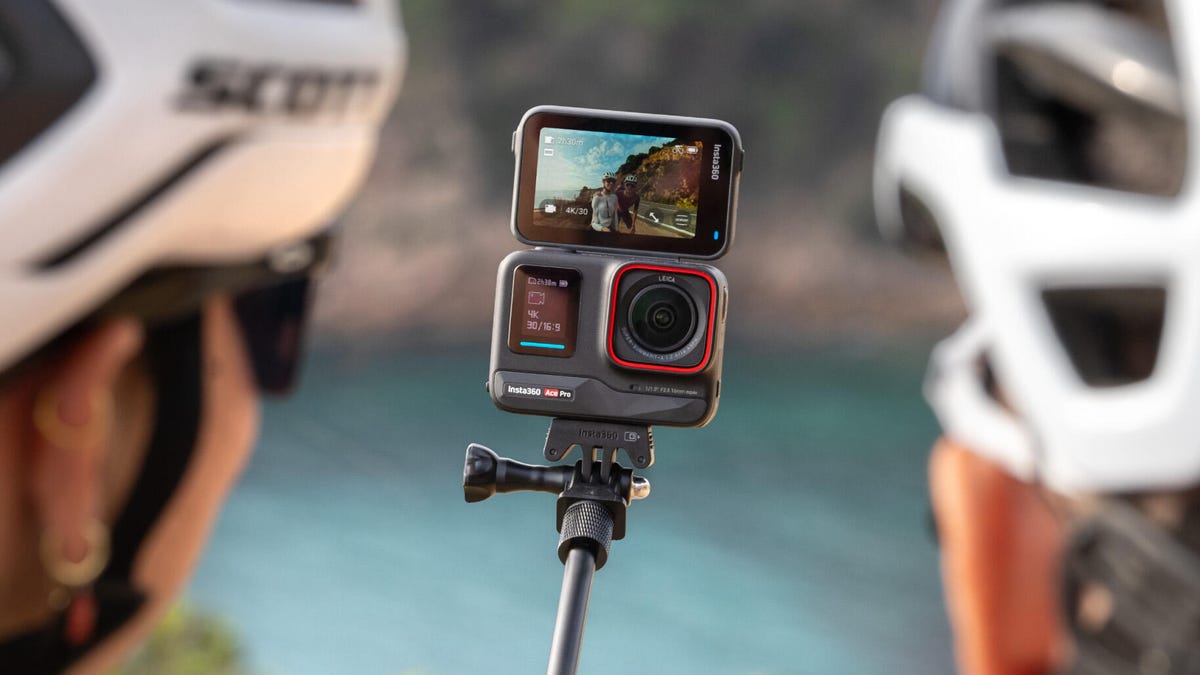 Why You Can Trust CNET
Why You Can Trust CNET Insta360 Ace Pro Action Cam Might Be the Low-Light Video Champ
With a big image sensor with an 8K resolution and some AI smarts, Insta360's action camera has cleaner low-light video and a lossless 2x zoom.

The Insta360 Ace and Ace Pro have a rear display that flips up for selfies.
Insta360 is best known for its 360-degree cameras and its innovative AI features that let you create some unique video edits, even if you don't know a thing about editing. But Insta360 never stays in one place for too long, and now it's adding GoPro-style action cameras to its lineup: the Insta360 Ace series. And it's anything but a carbon copy of the competition.
There are two cameras, the $450 Ace Pro (£430, AU$729) and the more budget-friendly $380 Ace (£360, AU$609). The main differences between the two are sensor size, lens quality and charging speed. The Ace Pro uses a 1/1.3-inch image sensor, while the Ace has a smaller 1/2-inch one; both models have wide-angle lenses, but the Ace Pro's was co-engineered with Leica to give it an edge in image quality; and the Ace Pro can fully charge in 46 minutes with a 30-watt charger, while the Ace takes 70 minutes.
The Ace Pro's image sensor is the same size as DJI's Osmo Action 4 camera and larger than GoPro's Hero 12 Black, which is a 1/1.9-inch image sensor. In general, a larger sensor is one way to get better image quality. Although the DJI Action 4 has the same size sensor, its video resolution tops out at 4K, and the Hero 12 Black stops at 5.3K, while the Ace Pro goes up to 8K (7,680x3,272 pixels) at 24 frames per second. But, like the Insta360's other cameras, the Ace Pro's extreme resolution is used for much more than just straight video capture.
For example, the camera's Clarity Zoom allows you to digitally zoom in on a subject with just a double-tap on the rear touchscreen. You can also take frame grabs from your videos at resolutions higher than what you're shooting resolution. There's also the option to shoot 48-megapixel photos in JPEG or DNG raw.
But the most important use of its big sensor for most people is PureVideo mode. Using a 5-nanometer AI chip for denoising, the Ace Pro can shoot cleaner, clearer low-light video with improved brightness and dynamic range. Other action cameras simply don't do well in dim or dark scenes and typically have to shoot without digital image stabilization, something that's not an issue for the Ace Pro.
Other features include:
- 2.4-inch flip-up touchscreen: Although the Ace and AcePro have small front displays to display settings and other statuses, they aren't selfie screens like other action cams. Instead, the whole 2.4-inch touchscreen on the back flips up so you can shoot selfies. It also makes it much easier to shoot with the camera above and below your sight line, like when it's mounted on handlebars.
- Active HDR video: HDR video reveals more details in high-contrast scenes, so you can see things normally lost in bright highlights and dark shadows. Capturing HDR video to demanding to begin with, but if you shoot at a resolution of 4K30 or lower with the Ace Pro, it can automatically turn on HDR and can be used with image stabilization.
- Cancel recording: Ever mess up your first take when recording yourself? You can immediately cancel the recording so they don't clutter up your microSD card and skip the whole playback-and-delete experience.
- Pause and resume recordings: This basically lets you edit while you're recording by letting you pause and resume, so you can eliminate uneventful moments in your videos without creating a bunch of clips.
- Apple Watch and Garmin integration: Insta360 says the Ace Pro is the first action cam with dedicated integration with a Garmin device or Apple Watch to attach GPS, speed and other data that can be added to videos.
The 2.4-inch touch display can be tilted up so you can frame shots when the camera is below or above your sight line.
The Ace and Ace Pro have all the other features that are standard on most of the company's other cameras. Those include a waterproof body (down to 33 feet, or 10 meters), FlowState image stabilization for shake-free video and AI editing assistance in its mobile app.
One last thing worth mentioning is the quick-release mount. It uses the same clip-on design as the mounts for its other cameras, like the smaller Insta360 Go, that just hooks into the bottom of the body and doesn't let go. This lets you move it from one mount to another with zero effort. You will need a special mount, though, if you want to quickly switch from shooting horizontally to vertically.

